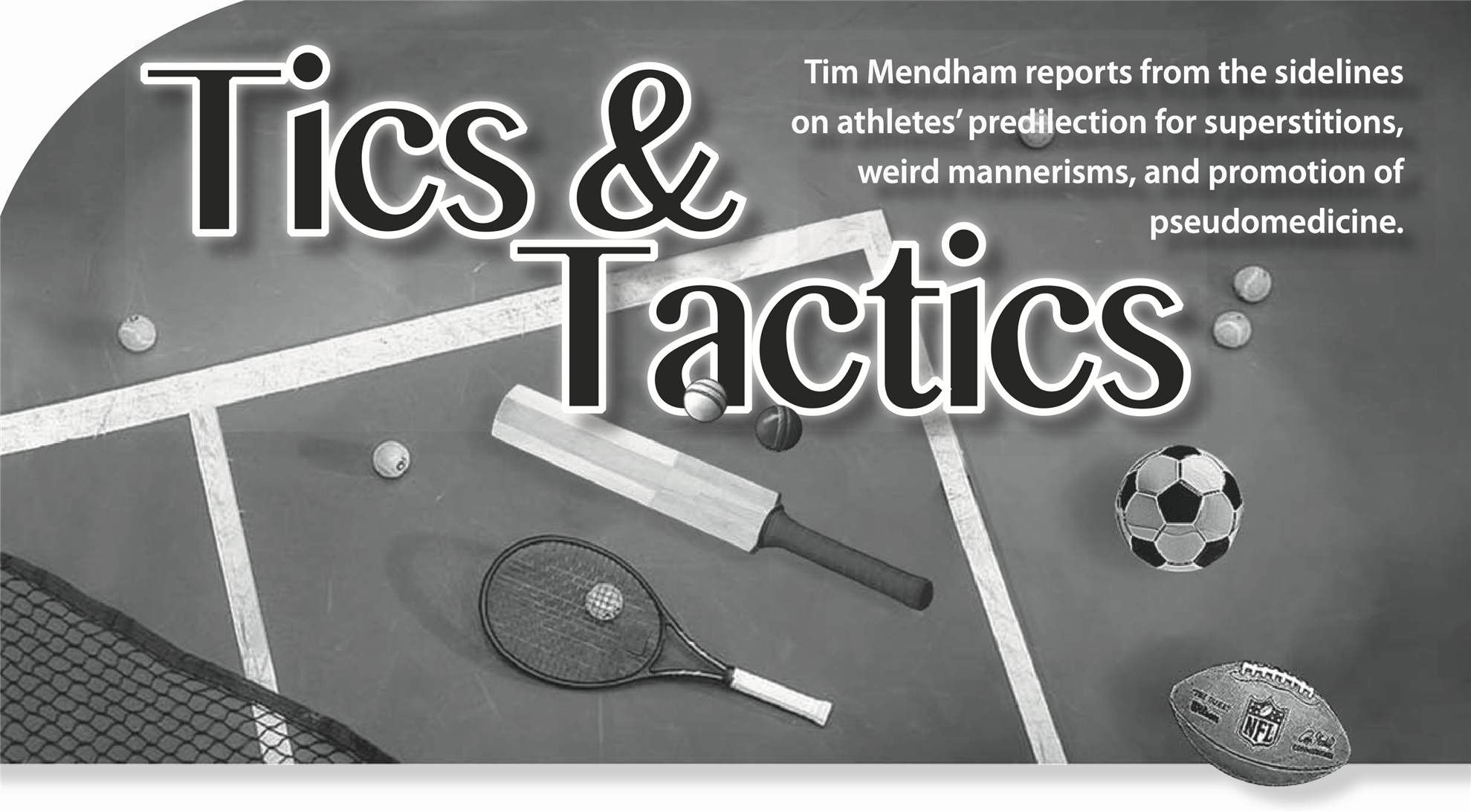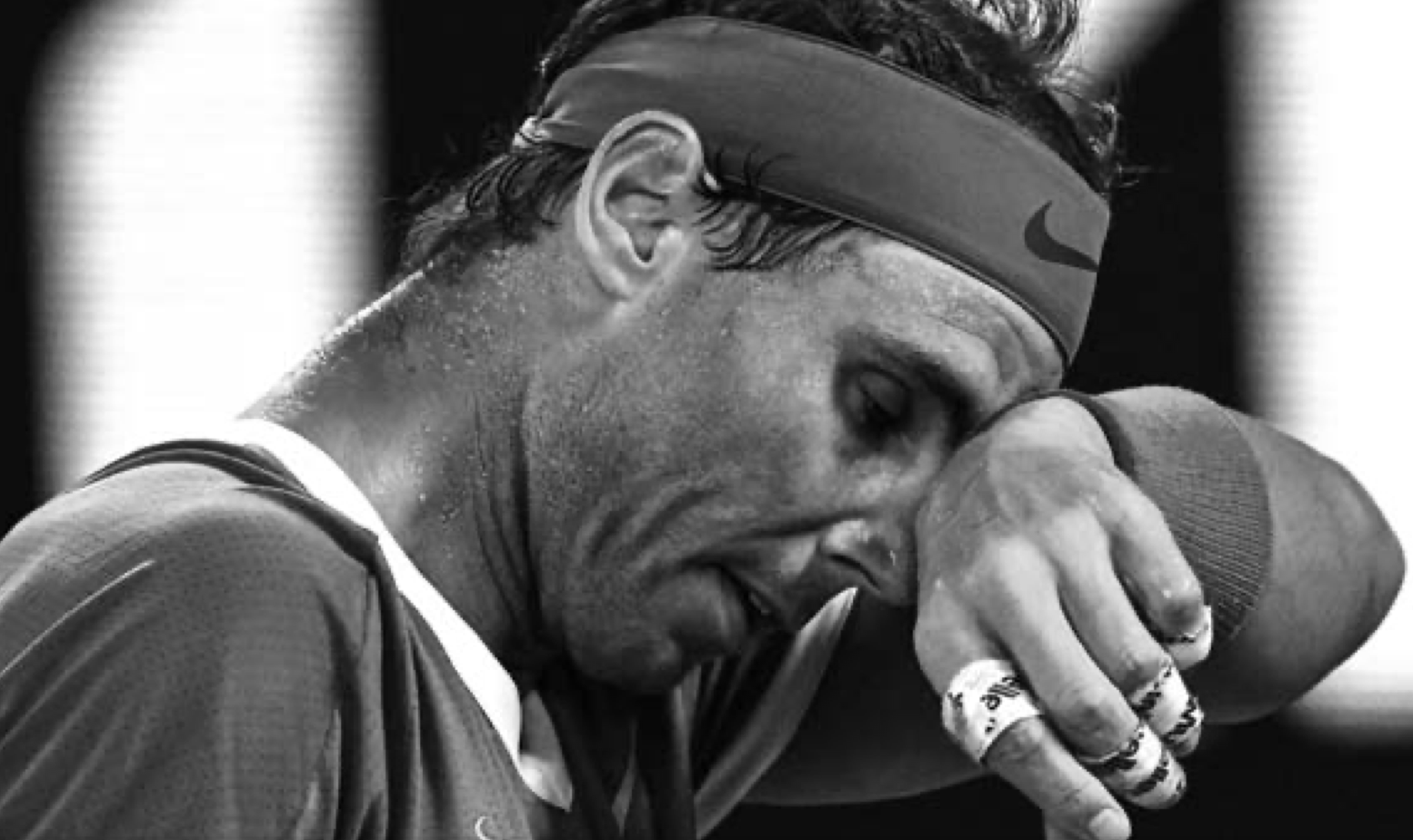 Tim Mendeham reports from the sidelines on athletes predilections for superstitions, weird mannerisms, and promotion of pseudomedicine.
Tim Mendeham reports from the sidelines on athletes predilections for superstitions, weird mannerisms, and promotion of pseudomedicine. It’s not uncommon to see elite athletes performing some sort of ritual before, during, and after play - soccer players cross themselves before going onto the field or taking a penalty shot, cricketers point to the sky on scoring a hundred runs in acknowledgement of a deity or deceased relative or former colleague, sprinters kiss a medallion before a race. There is a plethora of movements and tics performed before a key moment by a range of players.
Tennis player Rafael Nadal’s se ries of hand movements before every serve is noteworthy, and are just some of 19 superstitions which begin as soon as he enters the court before the start of the game. Nadal insists on not calling them superstitions, but rather mechanisms to help him focus. He always enters the court with a single racket in his hands, makes sure the logos from his water bottles are facing the court and before his games he takes freezing showers. “I do this before every match,” wrote Nadal in his 2011 autobiography about his showering ritual. “It’s the point before the point of no return. Under the cold shower I enter a new space in which I feel my power and resilience grow. I’m a different man when I emerge. I’m activated. I’m in ‘the flow’.”
ries of hand movements before every serve is noteworthy, and are just some of 19 superstitions which begin as soon as he enters the court before the start of the game. Nadal insists on not calling them superstitions, but rather mechanisms to help him focus. He always enters the court with a single racket in his hands, makes sure the logos from his water bottles are facing the court and before his games he takes freezing showers. “I do this before every match,” wrote Nadal in his 2011 autobiography about his showering ritual. “It’s the point before the point of no return. Under the cold shower I enter a new space in which I feel my power and resilience grow. I’m a different man when I emerge. I’m activated. I’m in ‘the flow’.”
 Another leading tennis player, Serena Williams, has her own set of rituals: bringing her shower sandals to the court, tying her shoelaces a specific way, wearing the same pair of socks during a tournament, and bouncing the ball five times before her first serve and twice before her second. She has blamed major losses on not correctly following her own routine.
Another leading tennis player, Serena Williams, has her own set of rituals: bringing her shower sandals to the court, tying her shoelaces a specific way, wearing the same pair of socks during a tournament, and bouncing the ball five times before her first serve and twice before her second. She has blamed major losses on not correctly following her own routine.
Of course, it’s not just athletes who occupy themselves in this way – whether it’s stroking a beard, scratching a nose or, in former Prime Minister Bob Hawke’s case, pulling on an earlobe, nerves and personal beliefs can play a part in every person’s twitches and tics, although many of these are unconscious mannerisms rather than learned behaviour with a particular purpose in mind.
But some have suggested that sports people are particularly prone to superstitious beliefs and unconscious nervous actions, and they are certainly more exposed publicly when they practise them than most people.
Whether these are nervous tics, unconscious medical symptoms, or movements designed to encourage good luck or ward off bad, they almost become a comfort to fans of particular players, who would be disappointed if their heroes don’t wipe the sweat from their foreheads, spin their rackets, or acknowledge the Almighty for a successful play.
Then again, players’ propensity for non-rational actions extends into the philosophies they adhere to, the treatments they undertake, and the often-spurious claims they promote. These are not unconscious actions but deliberately chosen methodologies to follow, and these are areas where fans might mimic rather than merely observe.
Obviously, athletes, and others, believe that their rituals are part of the self-efficacy regime. So how do they arrive at that position?
Superstition can be developed through causal and coincidental associations. Causal superstition refers to the conception of superstition through believing in a causal link between behaviour and influencing events despite the lack of any supporting scientific evidence.
Causal attributional explanation holds that people are generally inclined to attribute success to their skills and abilities, and to attribute failure to external circumstances. This could possibly explain why athletes and other superstitious believers are inclined to mistakenly attribute positive outcomes to their skills and abilities, which in reality occur as a result of luck.
This confusion between chance and ability may explain why people think they can influence luck by carrying out superstitious rituals, hence such beliefs and behaviours cannot be termed irrational. The paradox in performing a ritual or carrying a lucky object as a way of controlling external factors is that it may actually provide physical or mental relief to the point that it directly affects performance
 Superstitions actually help athletes who hold these beliefs to deal with pressure and to overcome mental and physical obstacles associated with a threat state.
Superstitions actually help athletes who hold these beliefs to deal with pressure and to overcome mental and physical obstacles associated with a threat state.
Whether the superstitions, the tics, the cures etc work, or whether they are an effective placebo, or just totally useless, the issue is that they are often seen as substitutes for effective health and fitness regimens, something which most athletes undertake in any case.
If the alternatives can be seen as a shortcut to success, bypassing established practises, then the influence of athletes becomes a serious and pernicious problem.
For better or worse, those who are at the pinnacle of their field, expressing the highest of physical achievement, have a responsibility to more than themselves.
But athletes are human, after all, and perhaps the higher up the ladder they go, the more vulnerable they are to pseudoscience, and more amenable to shonks and quacks. And the more everyone else follows them down whichever hole they might go.
 Tim Mendham is editor of "The Skeptic", and executive officer of Australian Skeptics Inc.
Tim Mendham is editor of "The Skeptic", and executive officer of Australian Skeptics Inc.